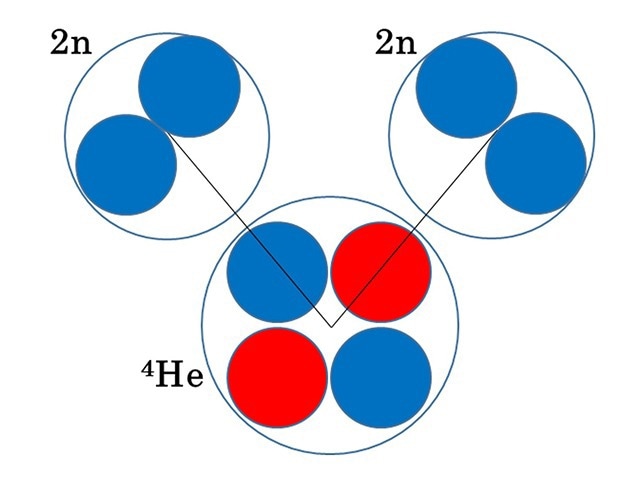Atomic nuclei are made of nucleons like neutrons and protons, which are bound collectively by nuclear force or strong interaction.

Two clusters of two neutrons (2n) exist around the helium-4 core. Red balls: protons. Blue balls: neutrons. Image Credit: Wataru Horiuchi, OMU
This force enables neutrons and protons to develop bound states, but when only two neutrons have been involved, the attractive force is not adequate to make such a state.
This calls for a question: would four neutrons be sufficient? This question has captivated atom physicists, who have actively sought to open this puzzle in experimental and theoretical realms.
With the availability of weakly bound nuclei, in which there is no powerful attraction from the center, taking two neutrons into account as a single unit is necessary for comprehending four-neutron correlations.
Hence, a research group headed by Associate Professor Wataru Horiuchi and Professor Naoyuki Itagaki from the Osaka Metropolitan University Graduate School of Science stressed the possibility of improved correlations between the two neutron pairs that consist of the four additional neutrons in the helium isotope 8He. (8He has two protons and a total of six neutrons.)
Extensive quantum mechanics equation calculations were performed by the research group and successfully illustrated the proof of dineutron-dineutron clusters divided around the 4He core before displaying the arrangement such clusters take.
Nuclei with an imbalance of protons and neutrons, such as in 8He, do not naturally exist on Earth but are believed to be generated abundantly in cosmic environments, such as in stars, through the process of nucleosynthesis. Our results provide new insights into the still largely unknown binding forms of neutrons and deepen our understanding of the origins of the elements around us.
Wataru Horiuchi, Associate Professor, Osaka Metropolitan University
This study was financially supported in part by JSPS KAKENHI Grants No. 18K03635, No. 22H01214, and No. 22K03618. The numerical calculations were executed utilizing the computer facility of Yukawa Institute for Theoretical Physics, Kyoto University (Yukawa-21).
Journal Reference
Yamaguchi, Y., et al. (2023) Dineutron-dineutron correlation in 8He. Physical Review C. doi.org/10.1103/PhysRevC.108.L011304.